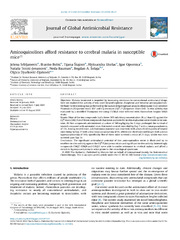Приказ основних података о документу
Aminoquinolines afford resistance to cerebral malaria in susceptible mice
| dc.creator | Srbljanović, Jelena | |
| dc.creator | Bobić, Branko | |
| dc.creator | Štajner, Tijana | |
| dc.creator | Uzelac, Aleksandra | |
| dc.creator | Opsenica, Igor | |
| dc.creator | Terzić-Jovanović, Nataša | |
| dc.creator | Bauman, Neda | |
| dc.creator | Šolaja, Bogdan A. | |
| dc.creator | Đurković-Đaković, Olgica | |
| dc.date.accessioned | 2020-09-07T10:22:08Z | |
| dc.date.available | 2020-09-07T10:22:08Z | |
| dc.date.issued | 2020 | |
| dc.identifier.issn | 2213-7165 | |
| dc.identifier.uri | https://cherry.chem.bg.ac.rs/handle/123456789/4054 | |
| dc.description.abstract | ObjectivesMalaria treatment is impeded by increasing resistance to conventional antimalarial drugs. Here we explored the activity of ten novel benzothiophene, thiophene and benzene aminoquinolines.MethodsIn vitro testing was performed by the lactate dehydrogenase assay in chloroquine (CQ)-sensitive Plasmodium falciparum strain 3D7 and CQ-resistant (CQR) P. falciparum strain Dd2. In vivo activity was evaluated by a modified Thompson test using C57BL/6 mice infected with Plasmodium berghei ANKA strain.ResultsNine of the ten compounds had a lower 50% inhibitory concentration (IC50) than CQ against the CQR strain Dd2. Five of these compounds that were available for in vivo evaluation were shown to be non-toxic. All five compounds administered at a dose of 160mg/kg/day for 3 days prolonged the survival of treated compared with untreated mice. Untreated control mice died by Day 7 with a mean parasitaemia of 15%. Among treated mice, a dichotomous outcome was observed, with a two-third majority of treated mice dying by Day 17 with a low mean parasitaemia of 5%, whilst one-third survived longer with a mean hyperparasitaemia of 70%; specifically, five of these mice survived a mean of 25 days, whilst two even survived past Day 31.ConclusionsThe significant antimalarial potential of this aminoquinoline series is illustrated by its excellent in vitro activity against the CQR P. falciparum strain and significant in vivo activity. Interestingly, compounds ClAQ7, ClAQ9 and ClAQ11 were able to confer resistance to cerebral malaria and afford a switch to hyperparasitaemia to mice prone to the neurological syndrome. | |
| dc.language | en | |
| dc.publisher | Elsevier | |
| dc.relation | Ministry of Agriculture and Environmental Protection of Serbia [decision no. 323-07-02444/2014-05/1]. | |
| dc.rights | openAccess | |
| dc.rights.uri | https://creativecommons.org/licenses/by-nc-nd/4.0/ | |
| dc.source | Journal of Global Antimicrobial Resistance | |
| dc.source | Journal of Global Antimicrobial Resistance | |
| dc.subject | Aminoquinolines | |
| dc.subject | C57BL/6 mice | |
| dc.subject | Hyperparasitaemia | |
| dc.subject | Malaria | |
| dc.title | Aminoquinolines afford resistance to cerebral malaria in susceptible mice | |
| dc.type | article | en |
| dc.rights.license | BY-NC-ND | |
| dcterms.abstract | Ђурковић-Ђаковић, Олгица; Србљановић, Јелена; Бобић, Бранко; Штајнер, Тијана; Узелац, Aлександра; Терзић-Јовановић, Наташа; Опсеница, Игор; Бауман, Неда; Шолаја, Богдан A.; | |
| dc.citation.volume | 23 | |
| dc.citation.spage | 20 | |
| dc.citation.epage | 25 | |
| dc.identifier.wos | 000604981100005 | |
| dc.identifier.doi | 10.1016/j.jgar.2020.07.027 | |
| dc.citation.rank | M22~ | |
| dc.type.version | publishedVersion | |
| dc.identifier.scopus | 2-s2.0-85090019754 | |
| dc.identifier.fulltext | https://cherry.chem.bg.ac.rs/bitstream/id/21459/Aminoquinolines_afford_resistance_pub_2020.pdf |


